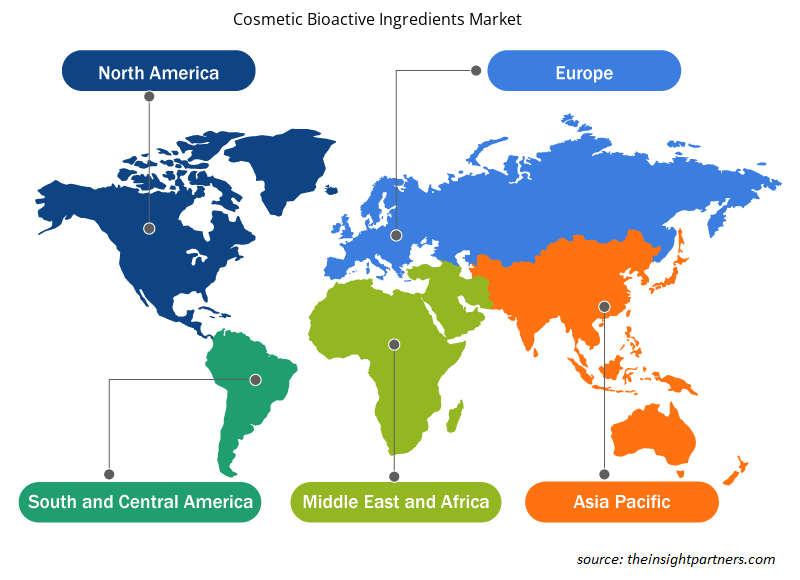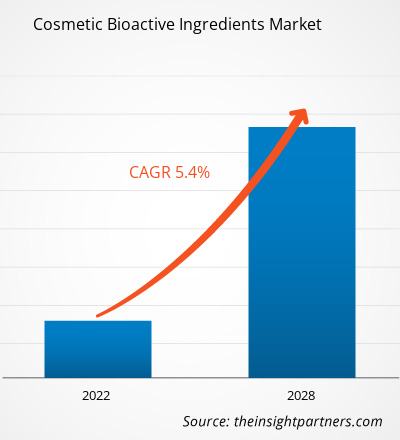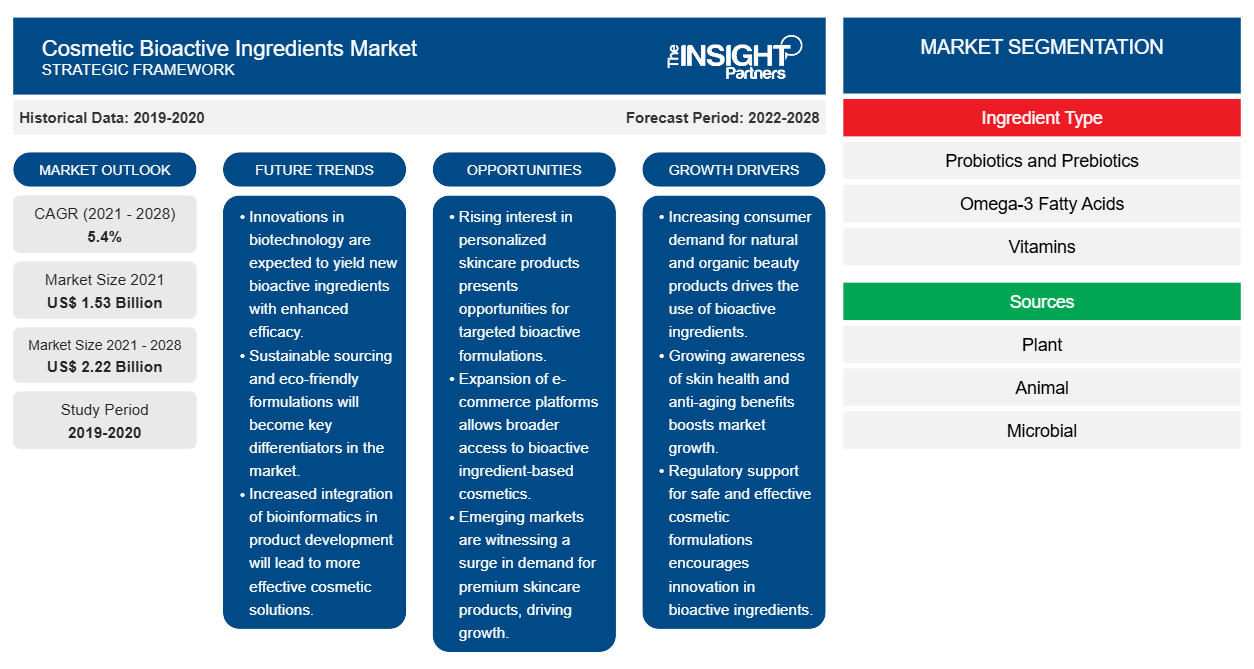化妆品生物活性成分市场规模预计将从 2021 年的 15.2991 亿美元增至 2028 年的 22.1596 亿美元;预计 2021 年至 2028 年的复合年增长率为 5.4%。
化妆品是用于清洁、美化、提升吸引力或改善外观的皮肤和头发产品。在这种制剂中通常使用的活性成分中,全球趋势是加入植物源产品,因为它们具有商业吸引力、安全性和丰富的成分,通常与协同或多功能效应有关。植物提取物富含存在于结构多样性高的植物中的次生代谢产物。类黄酮和非类黄酮都与有趣的化妆品特性有关,如光保护、抗衰老、保湿、抗氧化、收敛、抗刺激和抗菌活性。这些生物活性成分具有生物活性成分和药理作用,已被证明具有皮肤病学益处,可用于皮肤年轻化、光保护、伤口愈合等。化妆品生物活性成分市场的增长主要归因于人们对化妆品中天然成分的偏好日益增加,以及推出的生物活性成分数量不断增加。然而,严格的监管框架限制了化妆品生物活性成分市场的增长。
定制此报告以满足您的需求
您可以免费定制任何报告,包括本报告的部分内容、国家级分析、Excel 数据包,以及为初创企业和大学提供优惠和折扣
-
获取此报告的关键市场趋势。这个免费样品将包括数据分析,从市场趋势到估计和预测。
市场洞察
消费者对天然产品的需求不断增长,推动了可用于化妆品的生物活性物质相关研究。欧洲拥有一些最大的生物活性成分制造商和个人护理品牌,例如巴斯夫和帝斯曼。个人护理行业生物活性成分的推出正在推动市场的增长。2019 年 6 月,巴斯夫 Care Creations 为美容市场推出了三种新的活性成分,这些成分使用红毛丹树来为皮肤补水和恢复活力。同样,2019 年 4 月,龙沙推出了 H2OBioEV 生物活性成分,它是天然来源成分——水生隐孢子虫多糖和半乳糖阿拉伯聚糖——与水和甘油的独特组合。该成分通过补充必需的保湿剂赋予保湿能力,从而为形成和维持强大的表皮蛋白屏障提供最佳环境。
基于成分类型的洞察
根据成分类型,化妆品生物活性成分市场分为益生菌和益生元、ω-3 脂肪酸、维生素、类胡萝卜素和抗氧化剂、植物提取物、矿物质、氨基酸、蛋白质和肽等。氨基酸部分很可能在 2021 年占据最大的市场份额。然而,植物提取物部分预计将在预测期内实现最高的复合年增长率。
基于来源的洞察
化妆品生物活性成分市场按来源分为植物、动物和微生物。植物部分可能在 2021 年占据最大的市场份额。然而,微生物部分预计在预测期内在市场上的复合年增长率最高。
在化妆品生物活性成分市场运营的公司正在采用产品发布、并购、合作、产品创新和产品组合等策略,以扩大其全球影响力、维护品牌名称并满足最终用户日益增长的需求。
化妆品生物活性成分市场区域洞察
Insight Partners 的分析师已详尽解释了预测期内影响化妆品生物活性成分市场的区域趋势和因素。本节还讨论了北美、欧洲、亚太地区、中东和非洲以及南美和中美洲的化妆品生物活性成分市场细分和地理位置。

- 获取化妆品生物活性成分市场的区域特定数据
化妆品生物活性成分市场报告范围
| 报告属性 | 细节 |
|---|---|
| 2021 年市场规模 | 15.3亿美元 |
| 2028 年市场规模 | 22.2亿美元 |
| 全球复合年增长率(2021 - 2028) | 5.4% |
| 史料 | 2019-2020 |
| 预测期 | 2022-2028 |
| 涵盖的领域 |
按成分类型
|
| 覆盖地区和国家 |
北美
|
| 市场领导者和主要公司简介 |
|
化妆品生物活性成分市场参与者密度:了解其对业务动态的影响
化妆品生物活性成分市场正在快速增长,这得益于终端用户需求的不断增长,而这些需求又源于消费者偏好的不断变化、技术进步以及对产品优势的认识不断提高等因素。随着需求的增加,企业正在扩大其产品范围,进行创新以满足消费者的需求,并利用新兴趋势,从而进一步推动市场增长。
市场参与者密度是指在特定市场或行业内运营的企业或公司的分布情况。它表明在给定市场空间中,相对于其规模或总市场价值,有多少竞争对手(市场参与者)存在。
在化妆品生物活性成分市场运营的主要公司有:
- 荷兰皇家帝斯曼集团
- 味之素株式会社
- 罗盖特兄弟公司
- 腺苷二磷酸
- 巴斯夫
免责声明:上面列出的公司没有按照任何特定顺序排列。

- 获取化妆品生物活性成分市场顶级关键参与者概览
化妆品生物活性成分市场 –成分类型
- 益生菌和益生元
- Omega-3 脂肪酸
- 维生素
- 类胡萝卜素和抗氧化剂
- 植物提取物
- 矿物质
- 氨基酸
- 蛋白质和肽
- 其他的
化妆品生物活性成分市场 – 按来源
- 植物
- 动物
- 微生物
化妆品生物活性成分市场——按地区划分
-
北美
- 我们
- 加拿大
- 墨西哥
-
欧洲
- 法国
- 德国
- 意大利
- 英国
- 西班牙
- 欧洲其他地区
-
亚太地区 (APAC)
- 中国
- 印度
- 韩国
- 日本
- 澳大利亚
- 亚太其他地区
-
中东和非洲 (MEA)
- 南非
- 沙特阿拉伯
- 阿联酋
- 中东和非洲其他地区
-
南美洲 (SAM)
- 巴西
- 阿根廷
- 南美洲和中美洲其他地区
公司简介
- 荷兰皇家帝斯曼集团
- 味之素株式会社
- 罗盖特兄弟公司
- 腺苷二磷酸
- 巴斯夫
- FMC 公司
- Vytrus 生物科技
- 嘉吉公司
- Sensient 技术公司
- 杜邦
- 历史分析(2 年)、基准年、预测(7 年)及复合年增长率
- PEST和SWOT分析
- 市场规模、价值/数量 - 全球、区域、国家
- 行业和竞争格局
- Excel 数据集
近期报告
相关报告
客户评价
购买理由
- 明智的决策
- 了解市场动态
- 竞争分析
- 客户洞察
- 市场预测
- 风险规避
- 战略规划
- 投资论证
- 识别新兴市场
- 优化营销策略
- 提升运营效率
- 顺应监管趋势























 获取免费样品 - 化妆品生物活性成分市场
获取免费样品 - 化妆品生物活性成分市场